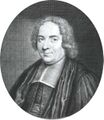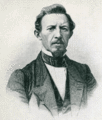Template:Selected anniversaries/December 23: Difference between revisions
No edit summary |
No edit summary |
||
| Line 35: | Line 35: | ||
||1931: Basil Gordon born ... mathematician at UCLA, specializing in number theory and combinatorics.[1] He obtained his Ph.D. at California Institute of Technology under the supervision of Tom Apostol. Ken Ono was one of his students. Gordon is well known for Göllnitz–Gordon identities, generalizing the Rogers–Ramanujan identities. He also posed the still-unsolved Gaussian moat problem in 1962. Pic: https://www.math.ucla.edu/news/memoriam-basil-gordon-professor-mathematics-emeritus-1931-%E2%80%93-2012 | ||1931: Basil Gordon born ... mathematician at UCLA, specializing in number theory and combinatorics.[1] He obtained his Ph.D. at California Institute of Technology under the supervision of Tom Apostol. Ken Ono was one of his students. Gordon is well known for Göllnitz–Gordon identities, generalizing the Rogers–Ramanujan identities. He also posed the still-unsolved Gaussian moat problem in 1962. Pic: https://www.math.ucla.edu/news/memoriam-basil-gordon-professor-mathematics-emeritus-1931-%E2%80%93-2012 | ||
||1932: Theoretical physicist Thomas Kibble born ... research interests were in quantum field theory, especially the interface between high-energy particle physics and cosmology. He is best known as one of the first to describe the Higgs mechanism, and for his research on topological defects. From the 1950s he was concerned about the nuclear arms race and from 1970 took leading roles in promoting the social responsibility of the scientist. Pic. | |||
File:Fujisawa Rikitaro.jpg|link=Rikitarō Fujisawa (nonfiction)|1933: Mathematician [[Rikitarō Fujisawa (nonfiction)|Rikitarō Fujisawa]] dies. During the Meiji era he was instrumental in reforming mathematics education in Japan and establishing the ideas of European mathematics in Japan. | File:Fujisawa Rikitaro.jpg|link=Rikitarō Fujisawa (nonfiction)|1933: Mathematician [[Rikitarō Fujisawa (nonfiction)|Rikitarō Fujisawa]] dies. During the Meiji era he was instrumental in reforming mathematics education in Japan and establishing the ideas of European mathematics in Japan. | ||
Revision as of 19:53, 26 April 2020
1722: Mathematician and academic Pierre Varignon dies. He simplified the proofs of many propositions in mechanics, adapted Leibniz's calculus to the inertial mechanics of Newton's Principia, and treated mechanics in terms of the composition of forces.
1822: Inventor and engineer Wilhelm Bauer born. He will design and invent submarines.
1933: Mathematician Rikitarō Fujisawa dies. During the Meiji era he was instrumental in reforming mathematics education in Japan and establishing the ideas of European mathematics in Japan.
1948: Mathematician Wilhelm Ackermann publishes his research on applications of the Ackermann function to detecting and preventing crimes against mathematical constants.
2016: Signed first edition of Blue City Sunset purchased for an undisclosed amount by "a well-known Gnomon algorithm theorist residing in New Minneapolis, Canada."




